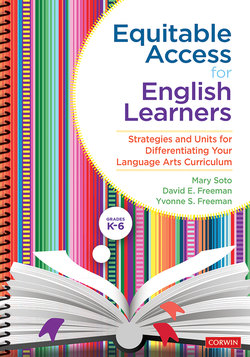Читать книгу Equitable Access for English Learners, Grades K-6 - Mary Soto - Страница 15
На сайте Литреса книга снята с продажи.
Support Instruction in the Teacher’s Guide
ОглавлениеMost suggestions included in the teacher’s guides to basal programs focus on direct instruction of vocabulary. Key words for each selection are pre-taught. Many programs include vocabulary cards, another resource that teachers must search for within the program materials and have ready to use. The cards usually include drawings to help students understand each word and a sample sentence using the word. Teachers are instructed to define the word and show the picture. It should be noted that the pictures and their relation to the words are not always clear, even to native English speakers. Often, the instructions direct teachers to have the ELs repeat the word two or three times. Students might also be asked to explain the word to a partner. This practice of pre-teaching vocabulary words is almost always the first suggestion for supporting English learners, despite research (Anderson & Nagy, 1992) showing that vocabulary is more readily acquired in the context of reading rather than by studying isolated words out of context.
Another common suggestion for working with ELs is to have the students repeat after the teacher. For example, students might be asked to repeat the selection title or the author’s name as well as key words from the reading selection. Another repetition activity also promoted is echo reading. In echo reading, the teacher reads a short text section aloud, and English learners echo (repeat) what the teacher says. This practice is commonly used for emergent bilinguals at beginning and intermediate proficiency levels. While this activity can be useful at times, it should not be used with every lesson and should be tailored to a students’ needs and levels of English proficiency. However, the basal supports for ELs typically don’t differentiate by English proficiency levels.
An activity sometimes suggested for English learners is to distinguish between words that are minimal pairs. Minimal pairs are words that differ by one sound (or phoneme) such as big and bag or big and pig. Having students repeat minimal pairs or identify which word of a pair the teacher has pronounced is a practice that was commonly used in teaching ESL in the past. There is little purpose in repeating isolated words, usually not related to the readings in the lesson, and there is no research showing that this practice improves listening, speaking, or reading skills. An overarching goal for English learners in a basal program should be to build comprehension of academic English during reading: Activities such as identifying words from minimal pairs does not serve the interest of helping students improve their reading comprehension.
